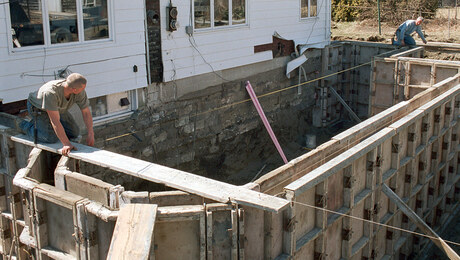Hola! I’m going to be doing a remodel with hydronic floor heat under mexican pavers. As always the budget is slim. To save money, I’ve heard that its possible to lay the tubing in a mortar bed instead of the more expensive light weight concrete products. Anyone know about any stability issues or any others, for that matter, that I should be aware of??
Discussion Forum
Discussion Forum
Up Next
Video Shorts
Featured Story

There are a number of ways to achieve a level foundation and mudsill.
Featured Video
SawStop's Portable Tablesaw is Bigger and Better Than BeforeHighlights
"I have learned so much thanks to the searchable articles on the FHB website. I can confidently say that I expect to be a life-long subscriber." - M.K.

















Replies
Pavers, or any kind of tile make nice RFH. They conduct heat nicely and feel so much better in the winter whne they are warm instead of cold.
I'd go with the smallest diameter tubing you can get, no more than 1/2 nominal size (than have a max loop length of 150 feet. 3/8" if you can find it (max length of 100').
What is the subfloor? Could you router into the subfloor to keep the tubing lower and not require so much grout?
I won't say no, but I've never seen it done that way. I suppose you could convince a tilesetter to pack deck mud around tubing, but... if I didn't want to use gypcrete, I'd use Warmboard and then tile backer board rather than a mud bed. If the floor is badly out of level I might rethink that, but I'd also consider a self leveling compound over the CBU.
Tile backer board could be placed between the runs of tubing. Snap the board into 11" widths. The board would come up most of the height of the tuing. It wouldn't need such a thick layer of grout. But the grout would thermally connect the tubing to the backer board and tile.David Thomas Overlooking Cook Inlet in Kenai, Alaska
>I'd use WarmboardHe said the budget is slim...
Yeah... it's always someone else's money, so I try not to get too worked up about it. I'm just not convinced that all the variations in thickness in a mud bed (where it went over the tubing) wouldn't lead to cracks and problems. Most tilesetters are going to want about an inch of mud, which would allow only 1/4" over a piece of nominal 1/2" PEX. I won't tell if you won't.
I've thinsetted cement board to the radiant panels that the tubes are set in. It does a great job transfering the heat to tile. I did snap lines where the tubes are as you still should screw down the board every 8 inches.